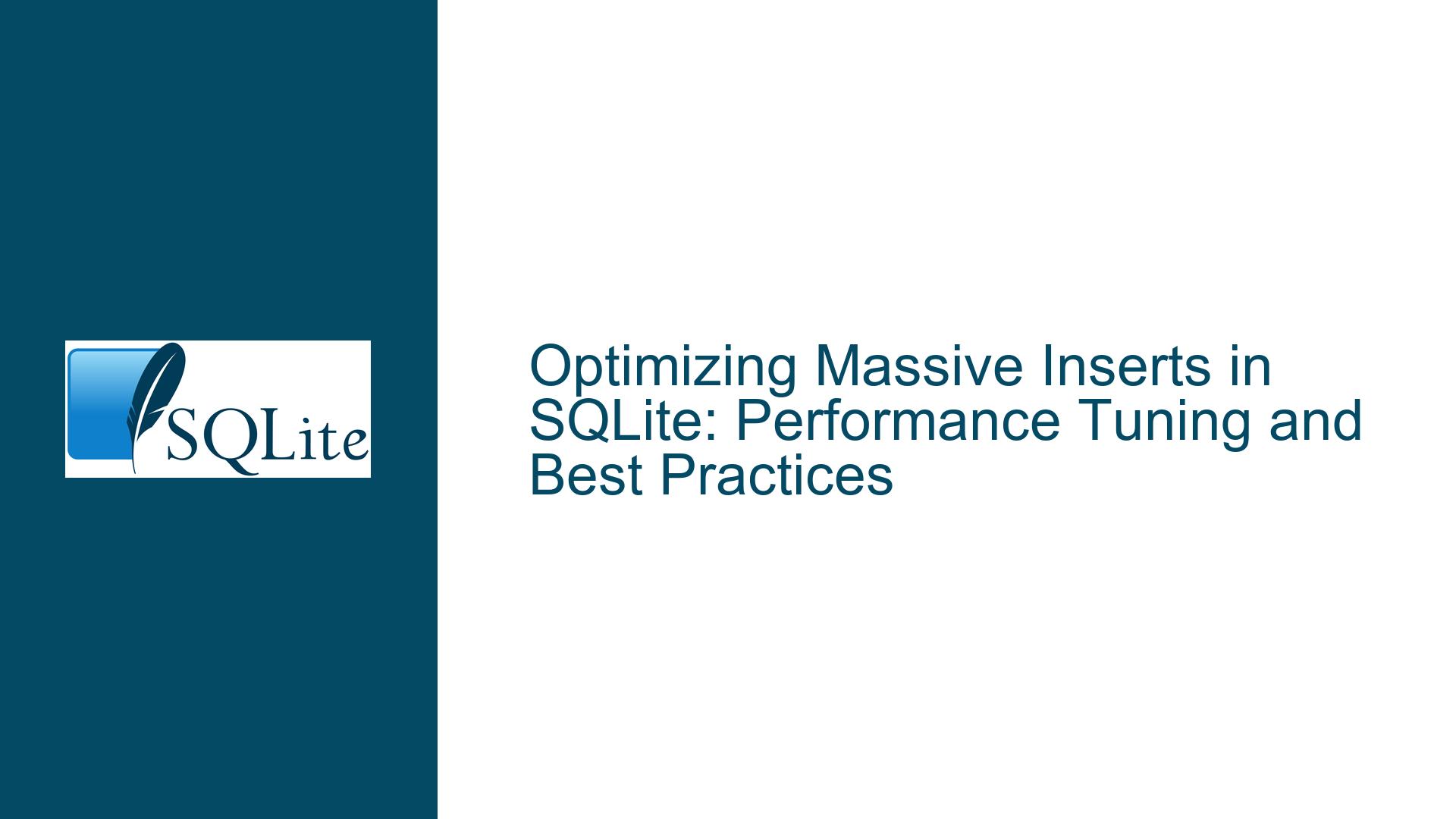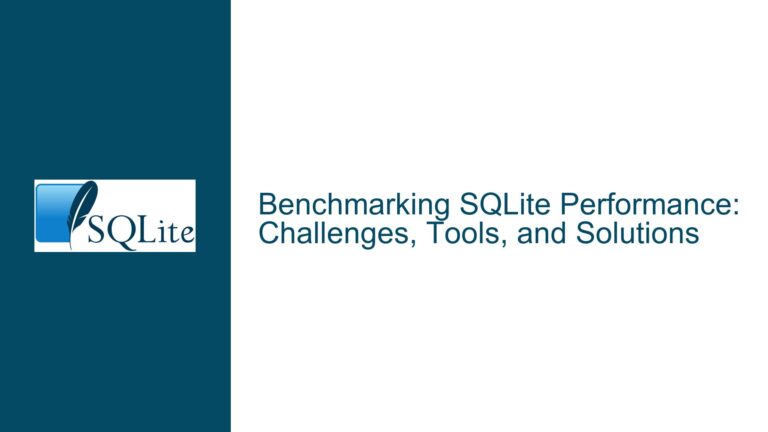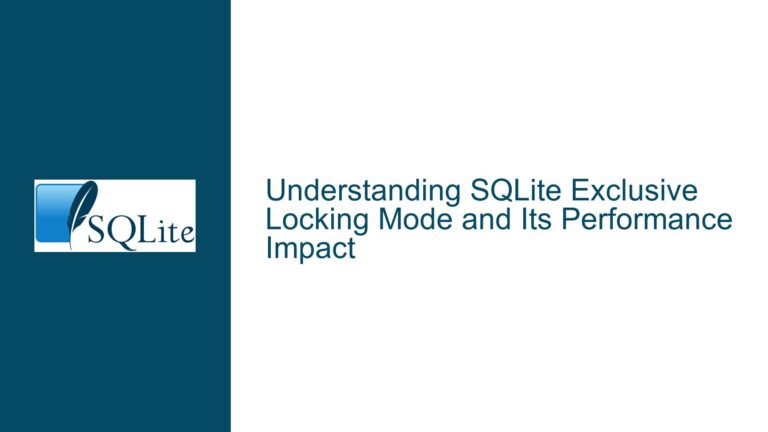Optimizing Massive Inserts in SQLite: Performance Tuning and Best Practices
Understanding the Performance Bottlenecks in Bulk Insert Operations
When dealing with bulk insert operations in SQLite, especially when handling large datasets spread across multiple database files, performance bottlenecks can arise from several areas. The primary goal is to minimize the time taken to insert millions of rows into a destination database. The scenario involves 2,000 database files, each containing a time_series table with approximately 12,000 rows, resulting in a total of 2.5 million rows to be inserted into a destination database. The current approach involves opening each database file, generating INSERT statements, and executing them within a transaction on the destination database. This process takes about 9 minutes, which is suboptimal for large-scale data operations.
The performance bottlenecks can be categorized into several areas: disk I/O, transaction management, SQL statement parsing and execution, and memory usage. Disk I/O is often the most significant bottleneck, as reading from and writing to disk is orders of magnitude slower than in-memory operations. Transaction management can also impact performance, as SQLite’s default behavior is to ensure ACID properties, which can introduce overhead. SQL statement parsing and execution can be CPU-intensive, especially when dealing with a large number of individual INSERT statements. Finally, memory usage and caching strategies can significantly affect performance, as SQLite relies on efficient memory management to optimize data access and manipulation.
Exploring the Impact of SQLite PRAGMA Settings and Alternative Insert Strategies
SQLite provides several PRAGMA settings that can be tuned to optimize performance for bulk insert operations. The current setup uses the following PRAGMA settings: journal_mode=OFF, synchronous=0, cache_size=4000000, locking_mode=EXCLUSIVE, and temp_store=MEMORY. These settings are designed to reduce disk I/O and improve performance by disabling the rollback journal, reducing the frequency of synchronous writes, increasing the cache size, locking the database in exclusive mode, and storing temporary objects in memory. However, these settings may not be optimal for all scenarios, and further tuning may be required.
One alternative strategy is to use prepared statements instead of constructing and parsing the text of individual INSERT statements. Prepared statements can reduce CPU overhead by precompiling the SQL statements and reusing them for multiple inserts. Another approach is to use JSON-based inserts, where data is serialized into JSON format and inserted using the json_each() function. This method can be faster than repeatedly calling a prepared statement or parsing a long SQL statement, especially when dealing with large datasets. Additionally, using INSERT INTO ... SELECT statements can significantly improve performance by eliminating the need to generate and parse individual INSERT statements. This approach allows data to be directly selected from the source tables and inserted into the destination table in a single operation.
Another consideration is the use of multi-threading to parallelize the insert operations. While SQLite is inherently single-threaded, multi-threading can be used to parallelize the reading of source database files and the preparation of data for insertion. However, care must be taken to ensure that the destination database is accessed in a thread-safe manner, as concurrent writes to the same database can lead to contention and performance degradation. Finally, the use of a custom VFS (Virtual File System) that manages database files in memory can further improve performance by reducing disk I/O and improving data access speeds.
Implementing Best Practices for Optimizing Bulk Inserts in SQLite
To optimize bulk insert operations in SQLite, it is essential to implement a combination of best practices that address the performance bottlenecks identified earlier. The first step is to ensure that the PRAGMA settings are appropriately configured for the specific workload. While the current settings are a good starting point, further tuning may be required based on the hardware and the nature of the data. For example, increasing the cache size can improve performance by reducing the number of disk reads, but setting it too high can lead to excessive memory usage and potential performance degradation.
Using prepared statements or JSON-based inserts can significantly reduce CPU overhead and improve performance. Prepared statements should be used when the same INSERT statement is executed multiple times, as they allow the SQL statement to be precompiled and reused. JSON-based inserts can be faster when dealing with large datasets, as SQLite can efficiently parse JSON data and insert it into the database. Additionally, using INSERT INTO ... SELECT statements can eliminate the need to generate and parse individual INSERT statements, further improving performance.
Multi-threading can be used to parallelize the reading of source database files and the preparation of data for insertion. However, care must be taken to ensure that the destination database is accessed in a thread-safe manner. One approach is to use a single thread to handle all database writes, while multiple threads are used to read and prepare the data. This approach can improve performance by reducing contention on the destination database and allowing the disk I/O to be more efficiently utilized.
Finally, the use of a custom VFS that manages database files in memory can further improve performance by reducing disk I/O and improving data access speeds. This approach involves copying the source database files into RAM and using a custom VFS to manage them. Once the files are in RAM, they can be attached to the destination database and the data can be inserted using a single transaction. This approach can significantly improve performance, especially when dealing with large datasets and high disk I/O workloads.
In conclusion, optimizing bulk insert operations in SQLite requires a combination of appropriate PRAGMA settings, efficient SQL statement execution, multi-threading, and custom VFS implementations. By carefully tuning these parameters and implementing best practices, it is possible to significantly reduce the time taken to insert large datasets into a SQLite database.






